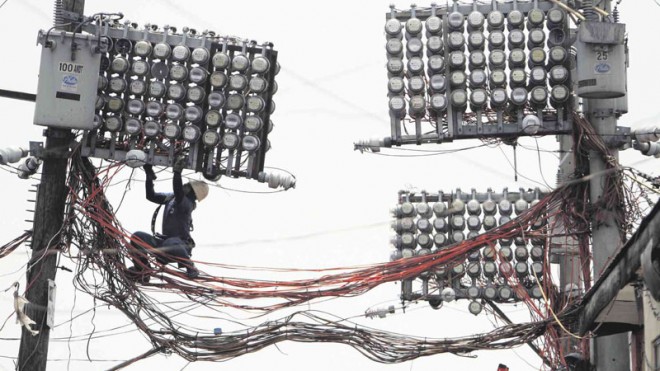MANILA, Philippines—Energy Secretary Carlos Jericho L. Petilla isn’t terribly concerned that demand for power is likely to peak when Metro Manila hosts the World Economic Forum (WEF) this week although supply remains precarious.
Petilla on Sunday acknowledged “thin reserves” as the power supply remained tight. Still, he said there was no special preparation for the WEF, as the energy companies were doing their best to keep the power situation stable.
“We will simply continue to monitor and ensure adequate supply at any time, WEF or no WEF,” said the chief of the Department of Energy (DOE).
DOE Director Mylene C. Capongcol said there would still be “tightness in supply” and that she expected the highest demand to peak on May 22 at 8,600 megawatts.
The National Grid Corp. of the Philippines (NGCP) said power supply could be just 9,273 MW for the day.
Unit 2 of the 1,200-MW Sual coal plant in Pangasinan province, operated by Team Energy Corp., went back online at 8:03 a.m. on May 17 after having been on shutdown since May 14. This allows the Luzon grid to have reserves, although “thin,” as Petilla said, amid the five-day emergency shutdown of Unit 1 of the 700-MW Pagbilao coal power plant starting May 16.
Alfredo S. Panlilio, Manila Electric Co.’s (Meralco) spokesman, said in a text message that Meralco was coordinating with the DOE, NGCP and other power companies on the supply situation for this week.
Meralco, Panlilio said, wanted to ensure minimal or, if possible, “nil” outages across the franchise. “We are also in touch with all ILP (Interruptible Load Program) partners just in case we need to call on them,” he said.
The ILP is a backup power plan where operators of huge power users, such as malls, condominiums, hotels and factories, are asked to use their own generators to ease demand from the grid. The program was employed on May 16 when the Pagbilao shutdown triggered rotating one-hour outages in parts of Manila, Quezon City, Caloocan City, Malabon City, Navotas City and Marilao town in Bulacan province from around 2 p.m. to almost 5 p.m.
The NGCP said that since power supply had been tight all summer, any drop in supply in large power plants would make electricity supply fall short of what consumers needed. Weekends usually meant lower power demand but weekday demand, especially this week, could test the industry’s mettle.
The Sy-led company does not control power supply, but during periods of generation deficiency, it does its best to mitigate the situation by implementing the grid-wide power load curtailment to maintain the grid’s security and reliability.
The company said it was closely monitoring the situation and continued to be in close coordination with the DOE to ensure that all the capacities available to the grid were dispatched efficiently.
NGCP, as system operator, issues grid operation notices to grid users. “Red alert” refers to the system condition when the contingency reserve is zero or a generation deficiency exists, while “yellow alert” is a condition where the total of all reserves is less than the capacity of the largest plant online, which for the Luzon grid, is 647 MW.
When system reserves are more than sufficient to meet the reserve requirements of the grid, the situation is considered normal. The system alert, and the corresponding power curtailment, if any, is lifted once demand recedes or once there is enough available capacity coming into the grid from the power plants.
RELATED STORIES
Red tape delays power woe solution
Osmeña: By 2015, power crisis will be blamed on Aquino
